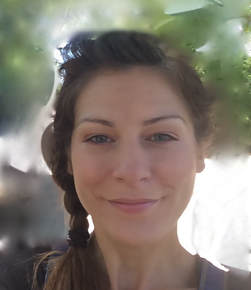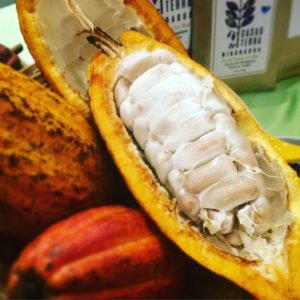Alumni Feature: Meaghan Gruber
Alumni Feature: Meaghan Gruber
Happy Dashain from Future Generations!
Happy Dashain from Future Generations!
A greeting from Himalayan Regional Academic Director and Assistant Professor, Mr. Nawang Singh Gurung:
Musings of a Naturalist IV: Loango: An Elephant Eden
Musings of a Naturalist IV: Loango: An Elephant Eden
Any thought of elephants immediately brings to mind the grim straits that the Forest Elephant and all elephant species face. Elephants need space but with habitat loss and fragmentation this is a fast diminishing commodity. Besides space, rampant poaching is a dire on-going threat that will be eliminated only when human needs are adequately met and when there is no market for ivory – or bush meat. There are many on-going efforts to deal with poaching so we retain the hope that elephants will indeed survive in the wild.
Gabon had received little conservation attention and Loango was almost unknown until zoologist Michael Fey’s well-publicized on-foot transect across the Congo Basin, a journey that ended in Loango in 2000. With Longo now on the map, the forward thinking prime minister, Omar Bongo, created the National Agency for National Parks in 2002, and this body decided to protect thirteen areas of special biological interest as national parks. These now occupy ten percent of Gabon’s land area.
While elephants, as a charismatic group, attract special conservation interest, their protection and the retention of their habitat also benefits many other species which, in Gabon, includes Lowland Gorillas, Chimpanzees, Red River Hogs, African Gray Parrots, and Slender-snouted Crocodiles, all indicator species of the Congo Rainforest Biome. And also benefitting from habitat protection are Giant Kingfishers, Palm-nut Vultures, and the African Rock Python, species I had previously encountered in other areas of Africa – but never in these numbers.
 |
|
Pictured is Dr. Fleming with a staff member of
Loango Lodge; the photo was taken on‘Gorilla Island’ near the
Loango National Park where there is a rehab center for rescued gorillas.
|
This week’s blog piece and photos make up the fourth installment in our Musings of a Naturalist series, courtesy of our own Dr. Robert (Bob) Fleming: Professor Equity and Empowerment/ Natural History. Having grown up in the foothills of the Himalayas in India, Bob has long been interested in the beauty of nature. This progressed into a fascination with natural history and cultural diversity, leading him to obtain his Ph.D. in zoology. He has explored many of the planet’s special biological regions, ranging from the Namib Desert in Africa to the Tropical Rainforest of the Amazon, and the Mountain Tundra biome of the Himalayas. He has worked for the Smithsonian’s Office of Ecology and the Royal Nepal Academy and, along with his father and Royal Nepal Academy Director-Lain Singh Bangdel, he wrote and illustrated “Birds of Nepal,” the first modern field guide to the birds of the region. In addition to his work with Future Generations, Bob is the director of Nature Himalayas, a sole proprietorship that he began in 1970. Through this company, Bob has led some 250 outings. He currently lives in the temperate rainforest of western Oregon in the USA’s Pacific Northwest.
Many thanks to Dr. Fleming for another great contribution!
Using the SEED-SCALE Model to Assess Access to Education in Engikaret, Tanzania
Using the SEED-SCALE Model to Assess Access to Education in Engikaret, Tanzania
 |
|
7th Year Students at ECPS.
Core Teachers: Sion and Priska.
Guest Teacher:Taylor |
Introduction
Principle One: Rising Aspirations Lead to Action
The Maasai of Engikaret live in a resource-poor and geographically isolated area, with an estimated population of 4,000. While resistant to overt cultural change, I found the Maasai of Engikaret open and willingly promote formal education as a means to generate opportunities within the community. The community’s openness to supporting formal education (such as enrollment in primary school) reflects Principal One of the SEED-SCALE model, which asserts that when promoting sustainable community programs, such as access to education, assessment leading to action should begin with evaluating the strengths of the community.
Within these strengths, I could see the hopes and dreams of parents wanting their youth to have the opportunity to attend primary school. As evidence, Engikaret has two primary schools. New Vision Primary School is a privately funded, faith-based school whereas Engikaret Community Primary School (ECPS) is a government funded, public school. While there are resource discrepancies between the two schools, the focus of my observations leads me to conclude that within the larger community context, there is a community-driven want to provide access to education for the youth of the area. Further, within the parameters of Principle One, is the need to assess how communities understand education as it relates to community health and well-being.
Officially, the community supports education, at least through the primary grades for the majority of the community’s children. I gleaned this informal information through participation in multiple Maasai community discussions. I had ample opportunities to meet with the mamas of Engikaret, who repeatedly stated that they want their children, regardless of gender, to be in school. While the position presented by the mamas highlights how the Engikaret Maasai have embraced social change through the verbal promotion of education, it is of interest that there are school-aged youth, primarily girls, who are not enrolled in either of the community’s primary schools. This observation led me to inquire about the rates of girl to boy enrollment within the public school system of Engikaret. Interviews with the public school teachers confirmed that more males are enrolled and supported in school attendance than girls. Perhaps this reflects traditions that “might create obstacles to healthy change.”
Evaluating challenges to healthy change does not mean to focus on the negative; rather Principle One acknowledges that when assessing community strengths one should not “ignore problems.” I suspect part of the reason for lower girl enrollment stems from the Maasai’s traditional gender roles. Traditional expectations of Maasai women are focused on marriage, child rearing, and home duties rather than on building gender equality through access to education. It is not to say the community does not embrace healthy change– from my observations of the Level Seven class at ECPS, I saw more female students enrolled than I had initially expected. Within the Level Seven class ,I calculated 43% of students were female, compared to 57% male. This data reflects a 23% increase in girl enrollment rates within the last generation.
 |
| Mamas of Engikaret |
Principle Two: Three-way Partnerships and Malleable Leadership
 |
| Maasai children herding after school and before the enrollment age of 7. NAU students: Aubrey Babcock and Taylor Lee |
Principle Three: Assessing Social Change through Community Perspectives
Conclusion
 This week’s blog contributed by Taylor Lee. Taylor has a passion for promoting equitable education in underserved communities, and is currently teaching in rural Arizona with predominantly Navajo youth. While her work is focused on delivering access to high quality science education at the middle grades, embedded within her classroom work is providing youth and families with meaningful experiences that inspire students to seek post-secondary opportunities. She believes that the cycle of poverty, often associated with under-resourced communities, can be broken when youth have equitable post-secondary options readily available. She works in collaboration with community partners to provide such pathways to her students through exposure at the middle grades level.
This week’s blog contributed by Taylor Lee. Taylor has a passion for promoting equitable education in underserved communities, and is currently teaching in rural Arizona with predominantly Navajo youth. While her work is focused on delivering access to high quality science education at the middle grades, embedded within her classroom work is providing youth and families with meaningful experiences that inspire students to seek post-secondary opportunities. She believes that the cycle of poverty, often associated with under-resourced communities, can be broken when youth have equitable post-secondary options readily available. She works in collaboration with community partners to provide such pathways to her students through exposure at the middle grades level.
Equip Yourself to Make the Change You Wish to See
Equip Yourself to Make the Change You Wish to See
 |
|
Gandhi’s ashram in Sevagram, India– participants in the certificate course Equip Yourself to Make the Change You Wish to See spend part of their course time here for an in-depth learning experience
|
Mahatma Gandhi coined the term swaraj (literally, self-rule, though he preferred to translate it as self-control) to describe the growing capacity of a population to determine its future. Gandhi was in South Africa at the time, and the idea of people rising up with internal nonviolent energy for political independence was a new concept in the world. His idea was that people could take control of their own destiny through taking control of the most basic functions of life. Colonialism was a loss of control, but so too was poverty, caste, and illness. From taking control over lives came true freedom; it allowed people to own their futures.
The Mahatma was not was not internationally recognized when he came to believe in swaraj. He wasn’t even in India or thinking of the independence of India, but wanted to improve a few lives in an intentional community on a very marginal piece of land in South Africa. What would grow into a freedom movement for one-fifth of the world’s population, indeed launch all the freedom movements of the 20th Century, began on a marginal piece of land and freedom for a few.
 Swaraj gave part of the answer, “a morality based in Truth” he often called it, a way by which people could define their destiny. His concern as his awareness grew was not simply opposition to the British Empire, but to the discrimination and poverty which underlay oppression. Fundamental social change was the objective, and the physical context for this control of destiny was the sparse land of his utopian South African Phoenix Colony. These then seeded an idea that would scale up into one of the world’s most powerful forces.
Swaraj gave part of the answer, “a morality based in Truth” he often called it, a way by which people could define their destiny. His concern as his awareness grew was not simply opposition to the British Empire, but to the discrimination and poverty which underlay oppression. Fundamental social change was the objective, and the physical context for this control of destiny was the sparse land of his utopian South African Phoenix Colony. These then seeded an idea that would scale up into one of the world’s most powerful forces.
In some of his writing after the movement had started to expand in India, Gandhi expanded the term to gram swaraj, which is community-based freedom. Gram swaraj generates sustaining energy for the community from inside and with it self-correcting direction. It is inspired and regulated by satyagraha, the energy of Truth. Gandhi argued that the true forces that bring change in the lives of people come not from the marketplace, not from armies, not from a religion, not from political process, but from knowledge of Truth that is internalized and adhered to so that it continually corrects action. These forces that begin inside each individual then redefine society to bring authentic help to all people.
His spinning wheel visibly conveyed this message on the importance of process and the search for Truth. Each individual turning his or her wheel gave evidence of self-potential and direction. The act of spinning used resources grown in that place, locally-grown cotton, locally-grown wood that made the wheels. When people wore khadi cloth they showed proof that a becoming life could be made by them. Done collectively, homespun khadi showed that India could weave a new life, using threads of local resources from one direction, massive energy of the villages from the other. Actually wearing these clothes of their own making as flags of self-reliance as they marched, India’s people gave evidence that they were dressing in a new way: their way. Do that, and from that other freedoms will grow. Swaraj was to strengthen India with tightly wound new fiber to pull apart deep forces of oppression: caste, poverty, ignorance, fear of leprosy, and gender discrimination.
Today, as military powers send soldiers to distant lands to free people and label the liberators “peacemakers,” and as corporations are freed to cross the world for cheap labor arguing that they create local development by creating jobs that bind people to global labor imbalances, the question must be asked (even if it cannot be answered): what is freedom? While freeing people from oppression and providing jobs are both freedoms, going toward freedom in the way that “peacemakers” and corporations pursue misses a core principle that guided Gandhi: that truth was in the process, the never-ending journey faithful to the operating principles.
 |
| Professor Taylor teaching Gandhi’s methods of social change at the Mahatma’s ashram in Sevagram, India |
Freedom is not given to people. Freedom is when people come together as communities to rule themselves. Joining together as communities not only liberates from these outside forces, but also it grows a momentum that, in his vision, would reach all. His was a vision for a new justice through new means: “If we are to make progress, we must not repeat history but make new history. We must add to the inheritance left by our ancestors.”
Inarguably, significant differences exist now than those present in people’s lives in Gandhi’s day. As such, it is helpful to focus just on that which Gandhi viewed as foundational: Truth. With information and instant access to anything people want to hear—information is awash now over the world pummeling people with falsehoods and facts. The worship of Truth is possibly more essential now than in Gandhi’s time. The response needed is not to abandon the quest and turn to fundamentalisms and black and whites, but to work with all the nuance that of how what is true in one locale is not in another, how what is true from one person’s perspective is not from another’s. Truth is understood through having a process to engage the facts and falsehoods. And so, a more complex set of principles is needed. To unpack in greater detail the principles Gandhi actually did use; we state them in the context of SEED-SCALE’s four principles:
 We can all still take inspiration from his perseverance and learn the lessons he left behind in his philosophy and methods. The application is timeless and invaluable in preventing history from repeating itself. By participating in Future Generations certificate course, “Equip Yourself to Make the Change You Wish to See,” you can learn Gandhian social change methods right where the Mahatma himself taught them to his followers, at his Sevagram ashram in central India.
We can all still take inspiration from his perseverance and learn the lessons he left behind in his philosophy and methods. The application is timeless and invaluable in preventing history from repeating itself. By participating in Future Generations certificate course, “Equip Yourself to Make the Change You Wish to See,” you can learn Gandhian social change methods right where the Mahatma himself taught them to his followers, at his Sevagram ashram in central India.
 This week’s blog contributed by Future Generations founder and current president and professor, Daniel Taylor. Daniel has been engaged in social change and conservation for four decades with a focus on building international cooperation to achieve ambitious projects. He founded the nine Future Generations organizations worldwide (including the accredited Future Generations Graduate School). He also founded and led The Mountain Institute. In 1985, after providing the scientific explanation for the yeti, he led creating Nepals Makalu-Barun National Park, then, in close partnership with the Tibet Autonomous Region, Chinas Qomolangma (Everest) National Nature Preserve and Four Great Rivers Nature Preserve protecting one-seventh of Chinas forest reserves. He is one of the synthesizers of the SEED-SCALE method, an understanding of social change initiated by a UNICEF task force he co-chaired from 1992-95. Since 1995 he continued to lead global field trials of SEED-SCALE and is senior author of Just and Lasting Change: How Communities Can Own Their Futures and Empowerment: From Seeds of Human Energy to a Scale of Global Change. Among his honors, Taylor was knighted by the King of Nepal Gorkha Dakshin Bau III; was made the first Honorary Professor of Quantitative Ecology of the Chinese Academy of Sciences; and was decorated with the Order of the Golden Ark by HRH Prince Bernhard of The Netherlands.
This week’s blog contributed by Future Generations founder and current president and professor, Daniel Taylor. Daniel has been engaged in social change and conservation for four decades with a focus on building international cooperation to achieve ambitious projects. He founded the nine Future Generations organizations worldwide (including the accredited Future Generations Graduate School). He also founded and led The Mountain Institute. In 1985, after providing the scientific explanation for the yeti, he led creating Nepals Makalu-Barun National Park, then, in close partnership with the Tibet Autonomous Region, Chinas Qomolangma (Everest) National Nature Preserve and Four Great Rivers Nature Preserve protecting one-seventh of Chinas forest reserves. He is one of the synthesizers of the SEED-SCALE method, an understanding of social change initiated by a UNICEF task force he co-chaired from 1992-95. Since 1995 he continued to lead global field trials of SEED-SCALE and is senior author of Just and Lasting Change: How Communities Can Own Their Futures and Empowerment: From Seeds of Human Energy to a Scale of Global Change. Among his honors, Taylor was knighted by the King of Nepal Gorkha Dakshin Bau III; was made the first Honorary Professor of Quantitative Ecology of the Chinese Academy of Sciences; and was decorated with the Order of the Golden Ark by HRH Prince Bernhard of The Netherlands.



















